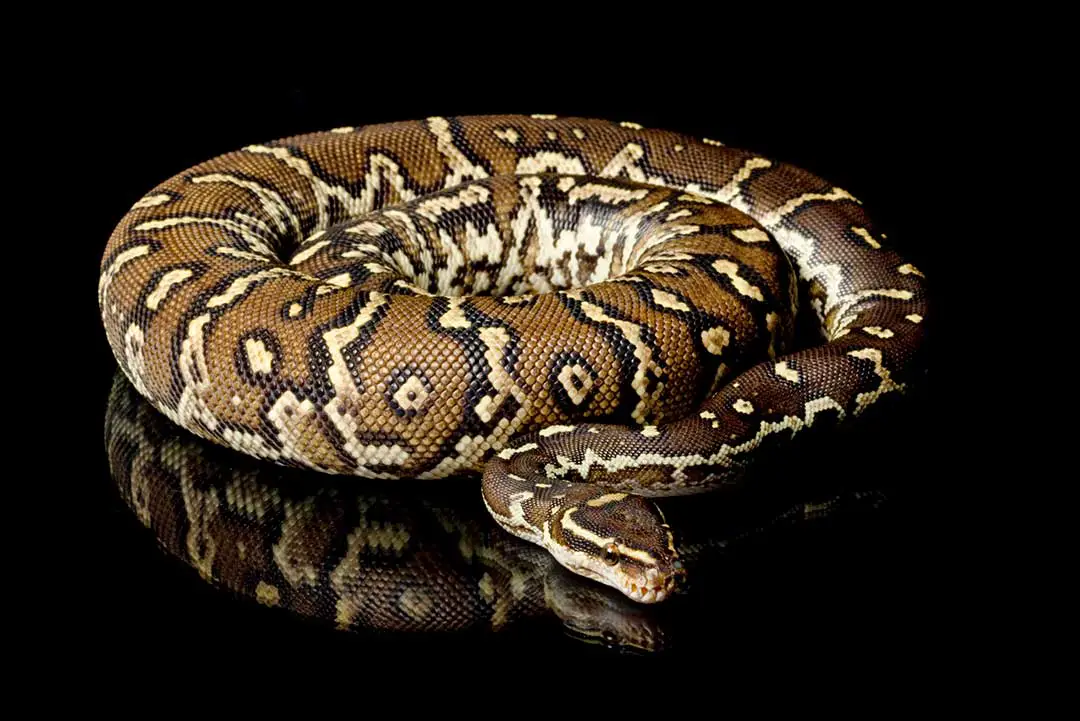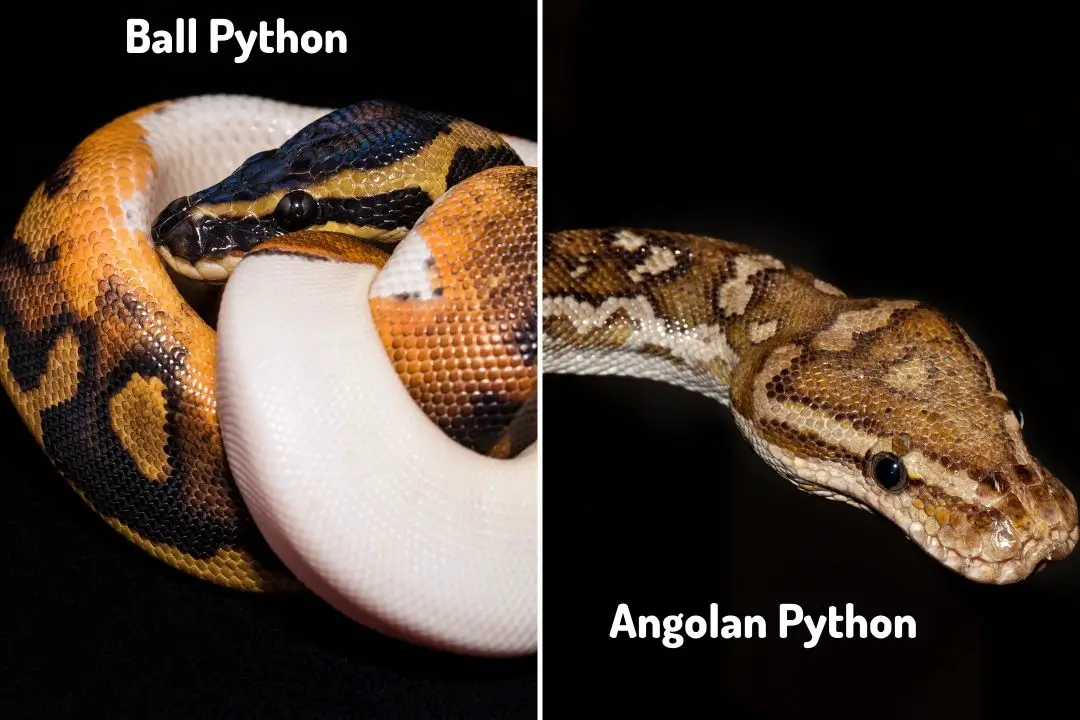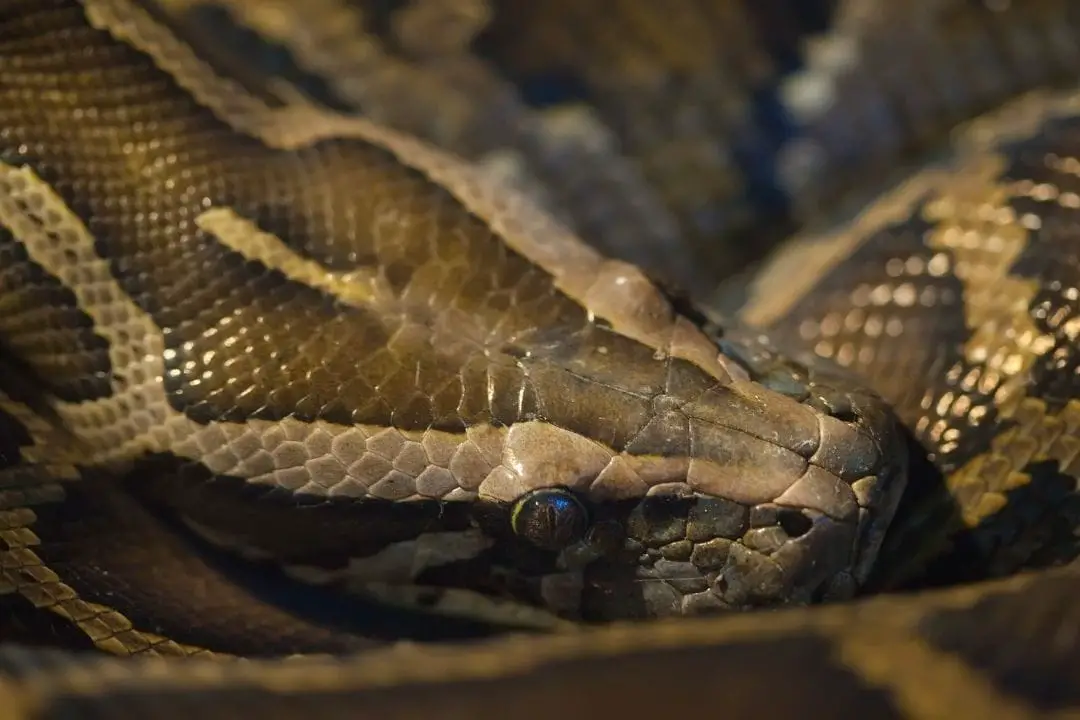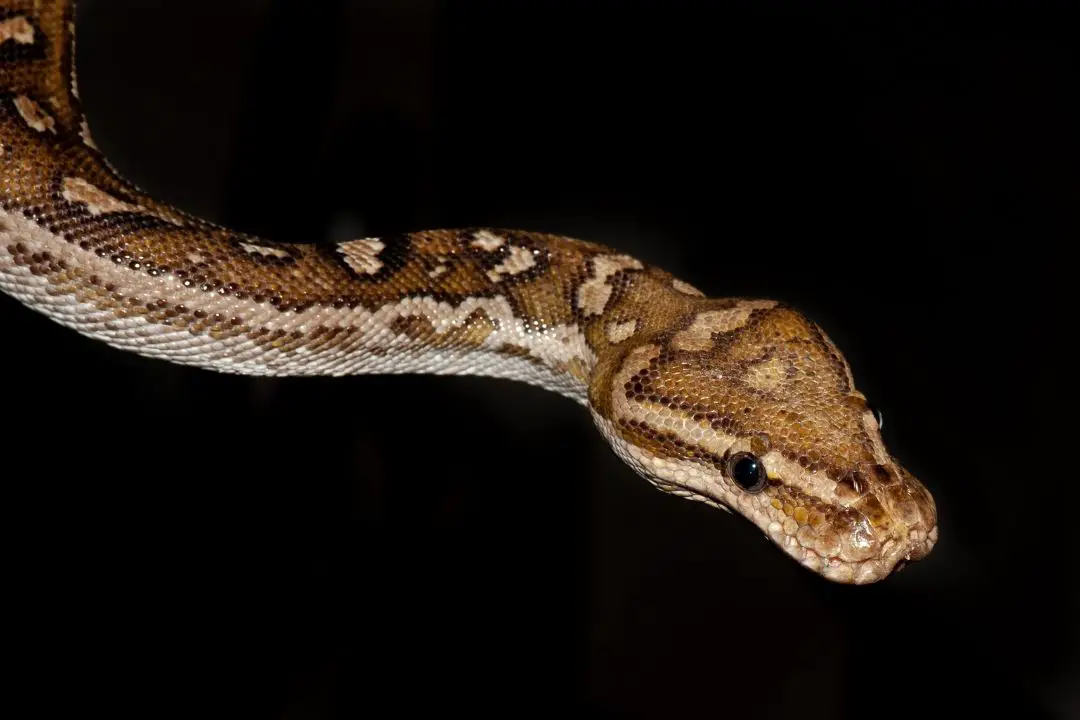The Angolan python (Python anchietae) is a brown python native to Southwest Africa from southern Angola to Namibia.
These snakes are typically found in rocky areas, grasslands, and shrubland in their native range.
They are rarely seen in the wild and poorly studied. If you want to own one of these beautiful snakes, be careful where you get your pet. This species is considered to be at risk of population loss thanks to the pet trade.
They are rare in captivity since much of their native range is still filled with land mines.
If you are lucky enough to have the option to own one of these snakes, this care sheet will help guide you on how to care for them.
Housing
The goal of any reptile enclosure is to create a slice of your snake’s native habitat. You should offer enough space for exercise and decorate heavily to offer plenty of hiding places and the option to climb around for exercise.
Your snake will spend all of its time in its enclosure, so make sure it will fill all of the snake’s needs.
Add ledges to give your snake options to climb on and ideally hide under. Use greenery to offer shade and hiding places and offer humid hides so your snake can control its own humidity. The more options the better, since it gives your snake choices.
Enclosure
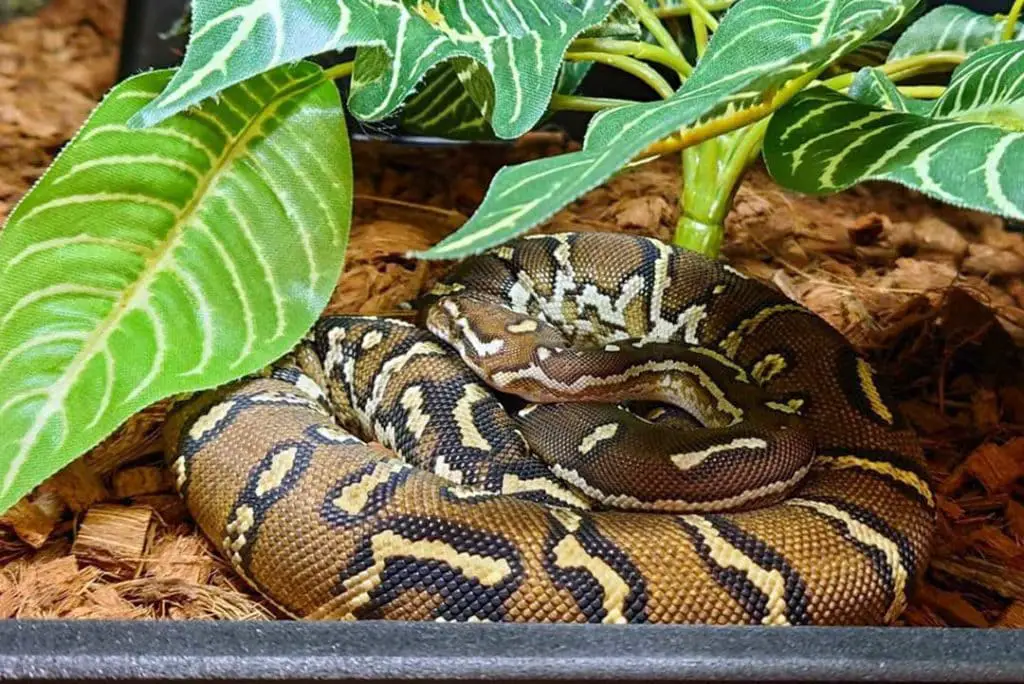
An adult Angolan python is somewhat thick, but they only reach 6 feet at maximum. This means it is fairly easy to find appropriate housing.
Just make sure the enclosure has enough space for the snake to fully stretch out and exercise. There should also be enough space for a big water dish and plenty of hiding spots such as ledges.
Decorations should include rocks, ledges, and plenty of cover for these snakes. More space is generally better since you can add more clutter to help a snake feel secure.
Make sure any enclosure has access for heating, holds the right temperature and humidity, and has a secure lock so your snake cannot escape.
Enclosure for Juvenile Angolan Pythons
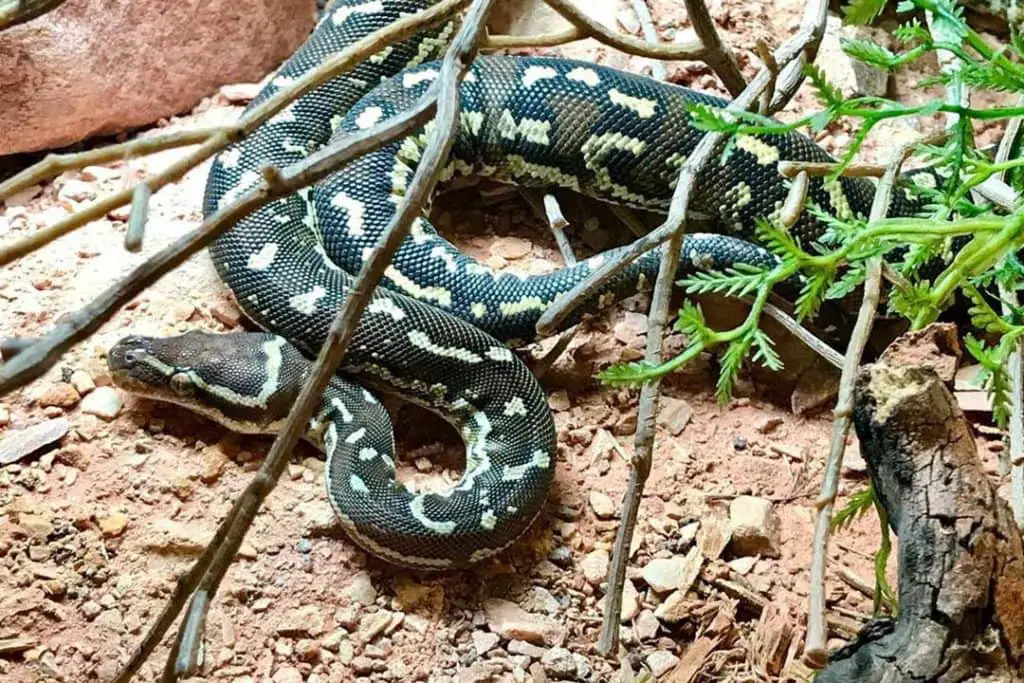
A freshly hatched Angolan python is about 17-18 inches long. They will double in size by a year old. Opting for an enclosure that is 3 feet will hold your snake for a long time.
If you feel like this is too large for your snake, you can always block off part of it until your snake has grown. This is a good way to save money and avoid buying multiple enclosures for young snakes.
Make sure to fill it densely since young snakes are generally shy and want to feel covered from potential predators. Always place snake enclosures in quiet areas and you can block off clear walls with construction or background paper to make sure your snake feels less exposed.
This is a great option for young snakes since it has secure locks, plenty of space, good ventilation, and easy access to heating. This should work until your snake reaches its full size.
These are very active snakes, so do not be tempted to go for much smaller since they will use every inch you offer unless the snake is too scared to leave the hide.
Enclosure for Adult Angolan Pythons
Adult Angolan pythons are 5-6 feet long generally.
What is the appropriate enclosure size for an adult Angolan python?
You will want an enclosure that is the length of your Angolan Python, half as long as your snake for width, and half the body length for height. This gives your snake plenty of space to stretch out, but you can always go larger if you would like.
Custom Reptile Habitats – PVC & Aluminum Enclosure – 72 L x 24 W x 24 H
- Sliding glass doors – Enjoy this big viewing area with crystal clear 1/4 inch Tempered glass that won’t scratch or discolor over time
- Stunning design with super strong Anodized Aluminum frame – Looks great in your home and will never rust or peel
- Real PVC panels – The preferred choice for reptile enclosures. Holds high humidity and will never break, rot or catch fire
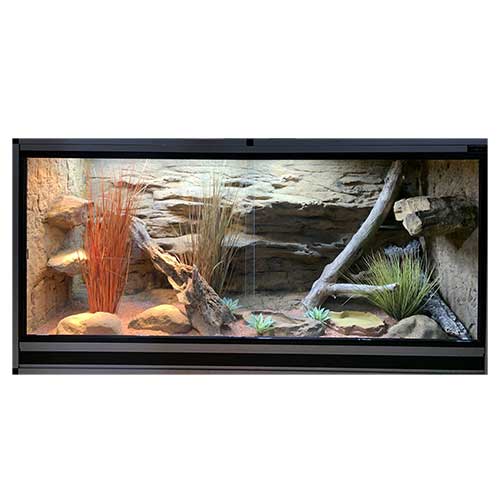
Since most snakes will be about 5 feet, a 60-inch x 24 x 24 will work nicely, but you should go larger for long females. These are active snakes that appreciate plenty of space.
One of the best tips for this species is to opt for backgrounds that include multiple sturdy ledges. This mimics the rocky ledges these snakes hide under in the wild. Adding greenery to help block these off can help your snake feel more secure.
Plastic type reptile cages like the terrarium above are a great option for this species since they offers more length to stretch out in.
Substrate
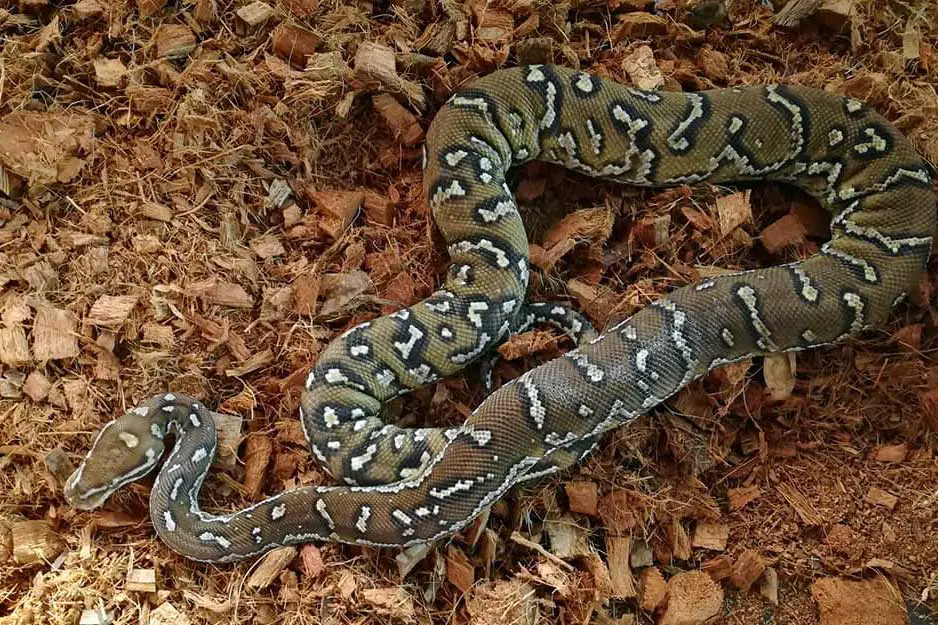
For a newly acquired snake, paper towel is a good option to monitor that the snake is urinating and defecating properly.
Technically, this can be used for the whole life of the snake, but it isn’t attractive and you need to remove all of the paper towels if your snake soils it.
Aspen is a great option for Angolan pythons since it allows a natural look and allows the snake to burrow if it would like. If you notice your snake likes to burrow, offer deeper substrate and place bark over portions so the snake feels more hidden.
You can also use options like Eco Earth or Repti Chip. These work nicely, And I do use and recommend reptichip. For Angolan Pythons though, be sure your substrate doesn’t hang onto too much humidity or your snake may experience skin infections.
Never use pine or cedar for reptile bedding. Any aromatic wood is toxic to reptiles. Be sure any bedding you use is free from herbicides and pesticides since these can kill a snake.
Heating
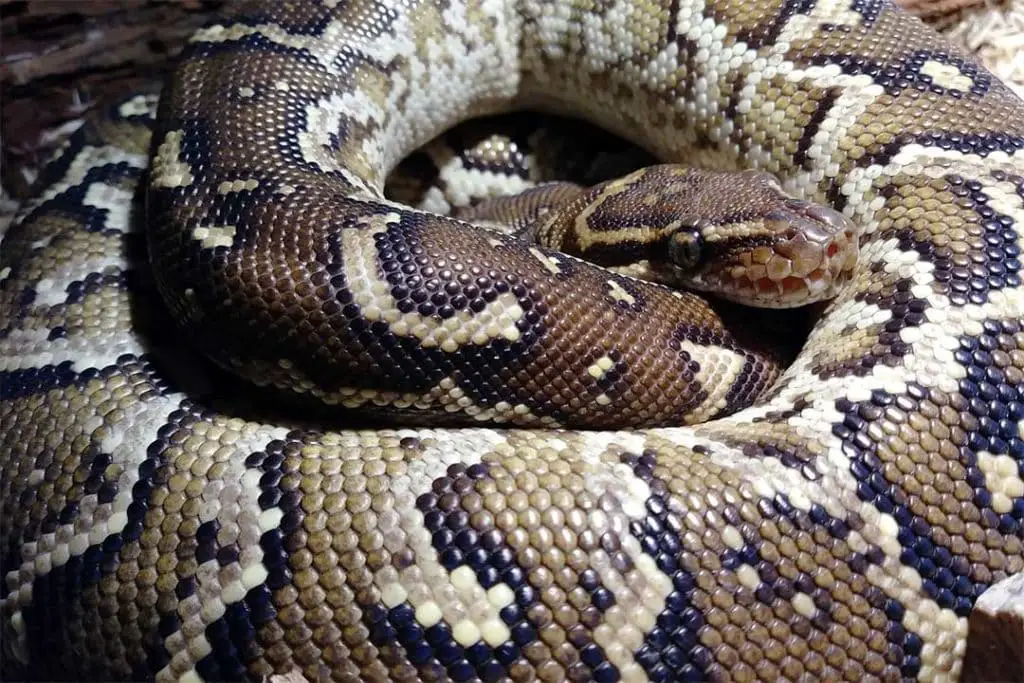
Since Angolan pythons are cold-blooded, your snake will need a temperature gradient to control its internal temperature.
A proper gradient with plenty of hiding options along it allows your snake to stay comfortable and secure.
Your snake needs to be able to control its temperature to ensure proper digestion and a healthy immune system. Half the tank should be heated. Poor husbandry will cause illness and even death if it isn’t corrected.
What is the correct temperature range for an Angolan Python enclosure?
Your Angolan python terrarium needs 87-90 degrees on the hot side and no lower than 75 during the day on the cool. By offering a big gradient, your snake can control its temperature easily.
Heating can be given by using under-tank heating controlled by a thermostat. Invest in a good quality temperature gauge or digital thermometer to monitor the temperature inside your enclosure.
Never use heat rocks since they can burn snakes. Never allow any heat pads or heating element to be accessed by your snake since it can cause severe burns.
If you have trouble keeping the temperature up with an under tank heat pad, you can use a supplemental heat source like a ceramic heat bulb in a heat-resistant dome to offer a basking spot.
This can also work if you have a thick substrate layer since a thick substrate can result in the air being too cold in many homes. Keep all heating on one side of the enclosure focused on a basking spot.
Ceramic heating bulbs work a bit better than basking bulbs since there is no light that needs to go off at night. They can tolerate High heat, and night temperatures can drop as low as 72 without harming your snake.
Light
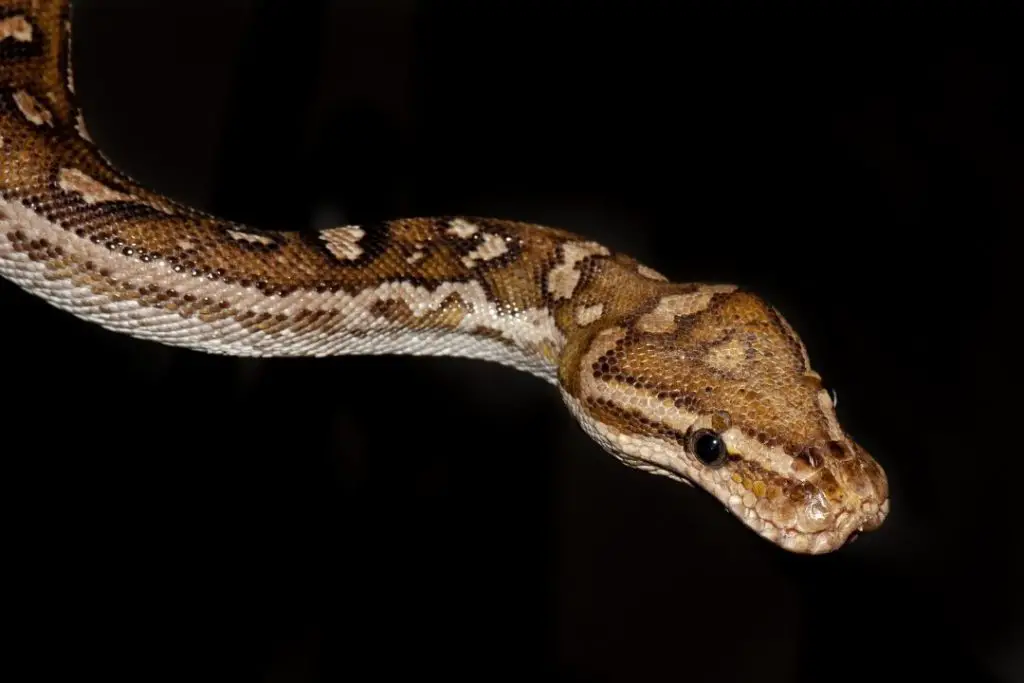
Angolan pythons do not typically need special lighting, but you can offer UVB inside a good quality light dome if you would like. Any lighting should be turned off at night since these snakes are nocturnal and will be stressed out by constant lighting.
Shelter
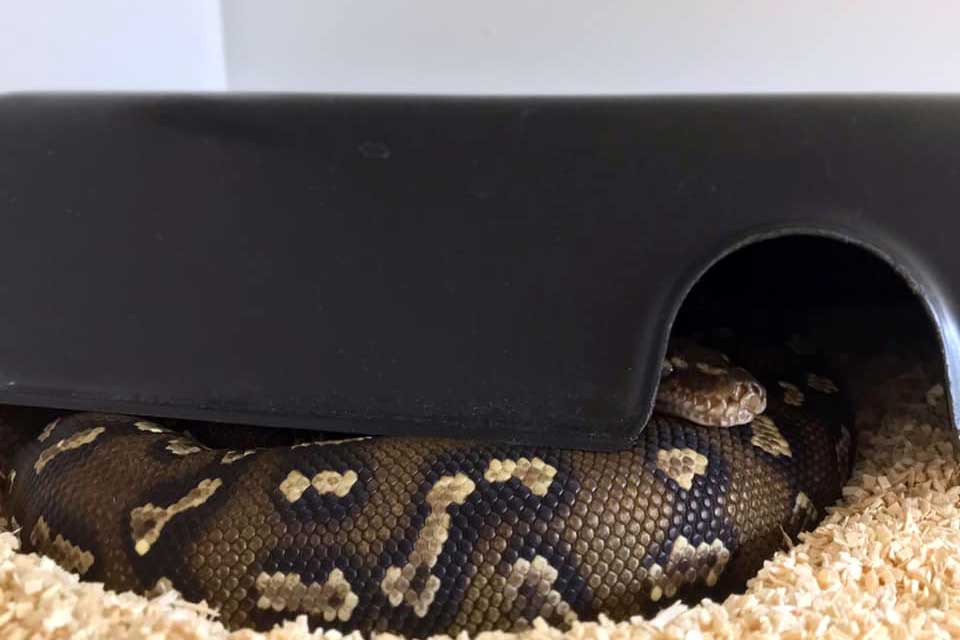
The anchieta’s dwarf python loves hiding under ledges. Since they love hiding in humid areas, at least one hide should be a humid hide filled with damp sphagnum moss.
Each side of the enclosure should have at least 1 hide, but you should add more including sheltered ledges and pieces of bark.
Snakes prefer an enclosure that will fit the snake’s whole body that has only one entrance. It should be snug without much extra space.
Water
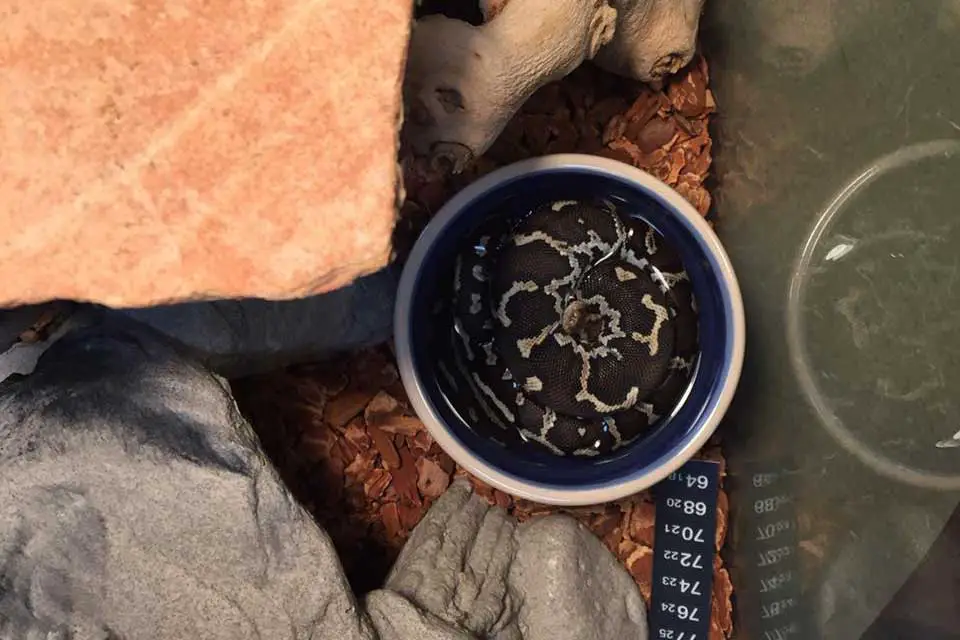
All snakes need access to fresh water. A wide and shallow dish can also help control humidity. Many snakes will also want to soak in the water when they are ready to shed.
Some snakes may also prefer to defecate in the water. Pick a solid, non porous water bowl or dish that is easy to clean and will fit your whole snake. This is a great option to start with:
Humidity
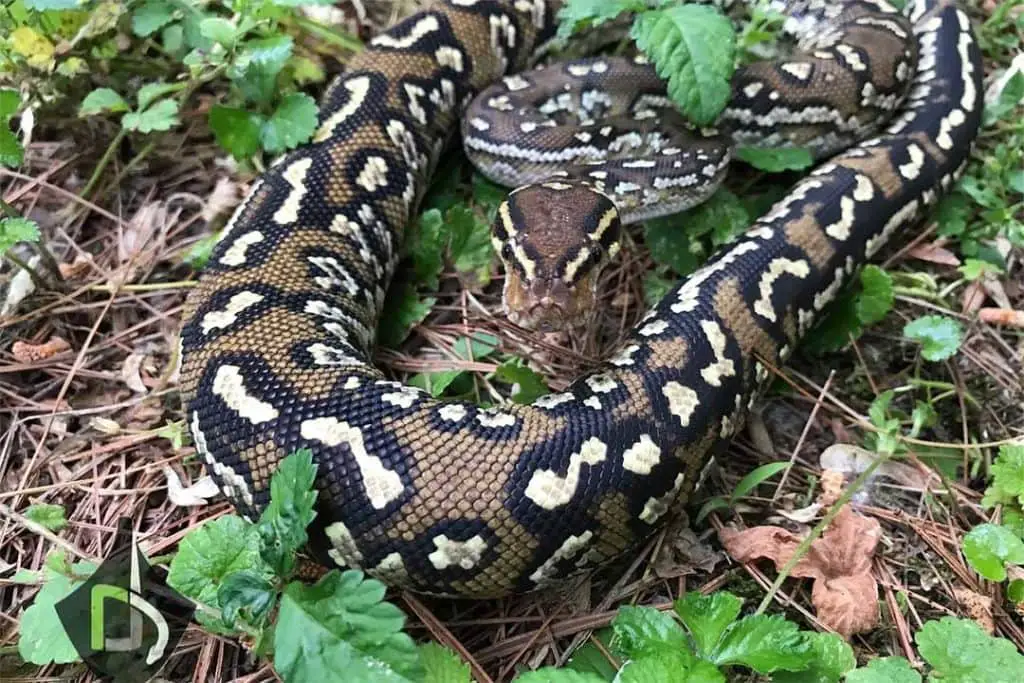
All snakes need a certain humidity maintained to keep the snake from becoming dehydrated. Low humidity can also cause shedding issues in snakes.
What is the required humidity levels for an Angolan Python?
Angolan python enclosures need to be kept at around 50% humidity. While their natural southern Africa range is pretty arid, most Angolan pythons will spend time hiding under ledges where the humidity is higher.
Make sure you offer a humid hide at all times. You can raise the humidity slightly when your snake is preparing to shed.
Always measure humidity with a digital hygrometer. The simple stick-on kind at the pet store is frequently inaccurate.
Enclosure Maintenance
You should be spot cleaning and replacing the water in the enclosure daily. Any soiled substrate should be removed and replaced.
The water dish should be washed weekly. About every three months, you will want to take out all the substrate and completely clean everything.
Be sure you buy a sanitizer that is safe for reptiles and follow the instructions. You should place your snake in a secure temporary enclosure like a tub with holes drilled in for ventilation.
Make sure your snake can’t push the lid off. Once your snake is secure, turn off all lighting and heating and take out all the decorations.
Remove and dispose of all the substrate. Next, scrub down all the surfaces and sanitize them. Rinse and dry thoroughly and level the enclosure open while you clean and sanitize all the hides.
Be sure to clean the water dish as well. Once everything is clean and dry, put in the new substrate and turn on the heating. Put all the decorations and hides back.
This is a great time to add some new things or change up placements to give your snake some mental enrichment. Once you are finished decorating, give your snake water and turn on the heating. Return the snake and make sure everything is securely locked.
Feeding
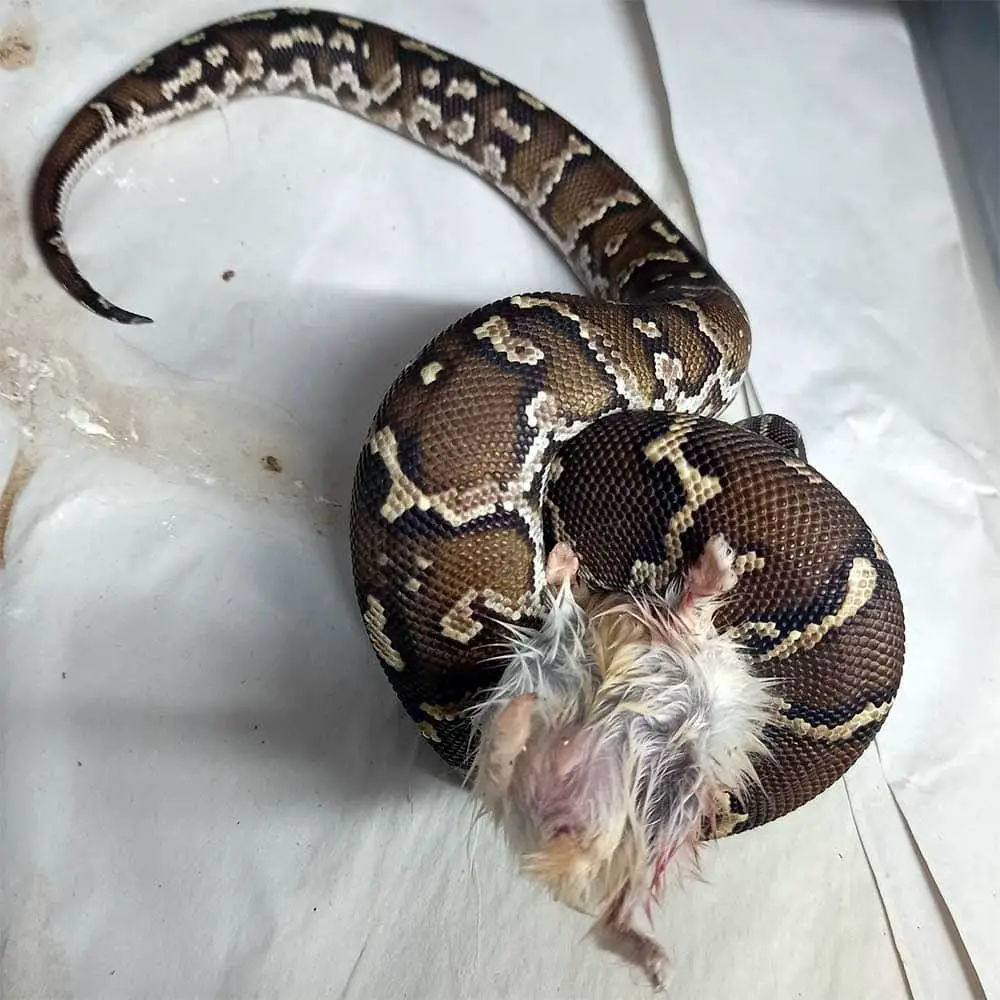
In the wild, these snakes eat small mammals, birds, and even insects. They are non-venomous constrictors that use very sensitive heat-sensitive organs to help them hunt primarily warm-blooded prey at night.
Type and Size of Prey
Captive Angolan pythons are typically fed rodents. They are easy to find and buy for your pet. Baby snakes may need to start off with mice, but you should switch your python to rats once it is large enough to handle newborn rats.
Never feed any prey that is wider than the thickest part of your snake. Feeding any larger can stress your snake and put it at risk of regurgitation.
You will learn what size your snake needs over time, but you can use about 10% of your snake’s weight as a guideline to start. This can make it easier to select the right size of prey for a new snake. Be sure you weigh your snake weekly.
Frozen Vs Live

There are pros and cons for feeding live versus feeding frozen/thawed prey. Live prey does allow for natural hunting behaviors. However, once your snake is large enough to take older rats, your snake is at serious risk of injury.
Rats are notorious for injuring snakes if you do not watch the entire interaction and intercede if your snake is being attacked. Never stun live prey since it will make the rat attack the moment it is no longer stunned.
It is also cruel to the rat. If you are feeding live because your snake only eats live prey, it may ignore still or stunned prey. You will also need to constantly get live prey for every feeding and have housing for the prey until mealtime.
Live prey always needs to be found in your local area and may be more expensive.
Frozen prey has the benefit of never needing to worry about your snake being hurt. Frozen prey should be safely thawed and then heated back to body temperature (angolan pythons have heat sensitive pits).
You can use feeding tongs to wiggle around a frozen rat to make it seem alive.
You can also buy frozen prey online and stock up on it. Frozen prey can be cheaper. You do need to be careful to thaw it safely by leaving it in the fridge for a day or so and then using warm water to get the thawed rat to reach about 100 degrees.
Some snakes will not take frozen prey, however. Angolan pythons tend to not be very picky, but some individuals may be picky.
How Often to Feed
How often should you feed an Angolan python?
Up until 2 years of age, you should feed your Angolan python weekly. Make sure the prey is the right size and your snake should be happy with this schedule. If you notice your snake developing fat deposits, it is time to increase the feeding intervals.
Most Angolan pythons over 2 years are fed every 2 weeks.
If you notice your anchieta’s dwarf python putting on too much weight, be sure to offer slightly smaller meals. You will learn what the best schedule is for your snake over time.
Shedding
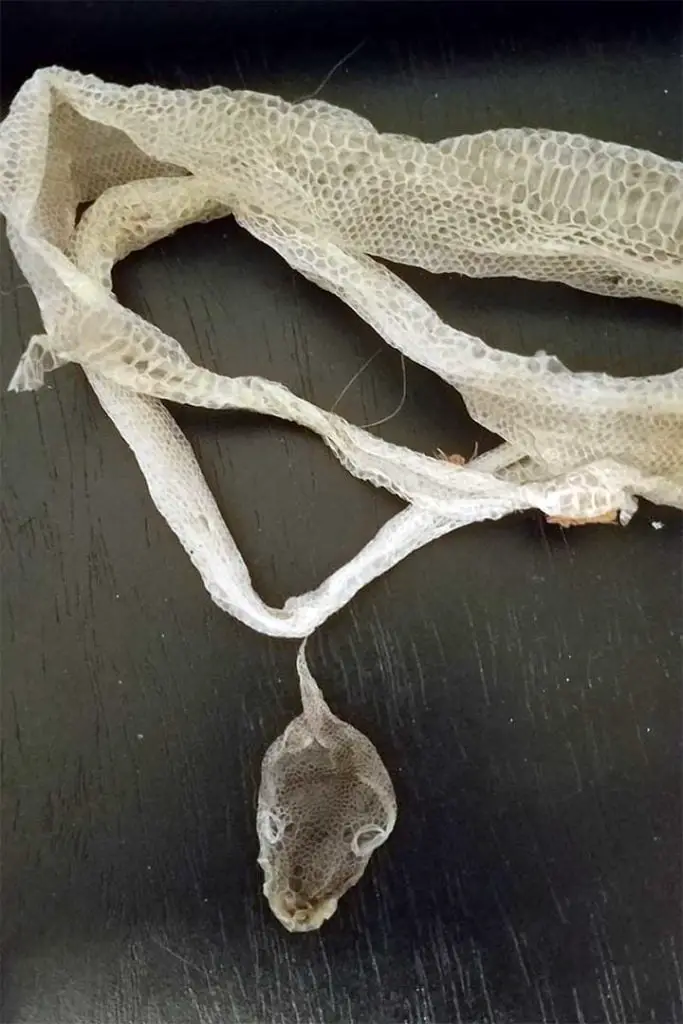
Shedding is how Angolan pythons grow larger, heal from injuries, and protect scales from wear. Younger pythons will shed much more often than an adult.
You may see your young python shedding every month or so while an adult will likely slow down unless they are injured. The first sign of shedding is when the eyes become cloudy. Since snakes do not have eyelids, a clear scale protects the eye from drying out.
When it is time to shed, fluid will fill the layers between the skin and separate the old layer. This fluid also helps to lubricate the skin and allows the snake to shed more easily.
A dehydrated snake can’t form this fluid as well and may experience a stuck shed. A stuck shed can cause infections if it is left on the snake.
Once your snake sheds, be sure to check the old skin to make sure it is intact. If you see pieces missing, you can use a tub with warm, damp paper towels to help soften the stuck skin and let it be removed without injury.
Always offer Angolan pythons humid hides and a large water dish to soak in to help prevent shedding problems. You can also slightly raise the humidity if you have shedding problems.
Handling Anchietae Pythons
Angolan pythons are similar to the related ball python in size and general temperament. However, Angolan pythons are less shy and tend to be more active.
They do enjoy a chance to explore their surroundings, but you should never leave a snake unsupervised outside of its enclosure. You should use hook training to help teach your Angolan python that it is not feeding time.
Any time you open the enclosure to handle your snake or clean, gently touch the snake with a snake hook or paper towel tube.
Then, you can gently take the snake out. If you notice yours is defensive when you try to take it out, you can use a snake hook to gently lift the snake out and transfer it to your hands. Never touch the snake’s head when it is still getting used to you.
Guide the snake by placing your hand under it and moving the snake away from where it should not go.
Always pick up snakes from below and support as much of the body as you can. Watch the snake to make sure it is calm and keep any early handling sessions to under 5 minutes.
Allow the snake to relax and watch for slow tongue flicks and exploration.
Always end gentle handling sessions on a positive note by returning the snake when it is still relaxed. If the snake bites you, keep handling it for about a minute so it doesn’t learn that biting you is the fast way to get put back in its home.
Common Issues
This will cover a few common concerns with the python anchietae (angolan python scientific name). If your question isn’t answered here, feel free to ask it below.
My Angolan Python Won’t Eat
While Angolan pythons tend to be fairly reliable with food, they may refuse. Sometimes it may be the season. Breeding season means that some snakes may refuse to eat.
Winter may also make your snake sluggish and less willing to eat. A healthy angolan python that is in shed may also refuse to eat. Finally, many illnesses can cause a loss of appetite. If your snake is suddenly refusing meals, head to the vet immediately.
Typical Illnesses
The most common illnesses in any captive snake are infection. Mouth infections can be caused by poor husbandry or injury from live prey.
Watch for pus or blood in your snake’s mouth and color changes. Respiratory infections can kill a snake very quickly. If you suspect one, take your snake to the vet immediately.
Listen for any sounds like wheezing or clicking. If you see mucus coming out of the nostrils or the snake breathing with the mouth open, head in.
You may also notice your snake breathing more heavily if it is ill. Skin infections can be caused by injury or too much humidity. Monitor your humidity and look for any unusual skin changes during handling sessions.
Your Angolan python should have bumpy scales, and any changes are worth a vet visit. Parasites are also an issue. Ticks and mites can be seen either on the snake or drowned in the water dish since snakes will try to soak off parasites.
Internal parasites can be detected with testing. Always have your new snake tested at the vet and monitor the feces for any unusual changes.
My Angolan Python Regurgitated
Regurgitation is a serious issue for snakes. It is very stressful and can injure or kill a snake. The most common cause is the prey item being too large.
Anchieta’s dwarf python will regurgitate if they feel they can’t digest their meal fully. Always offer smaller meals. If your snake regurgitates, wait for 2 weeks before offering another meal. If it happens twice in a row, head to the vet.
Sources
- Angolan python – Leigh Valley Zoo
- The maintenance and reproduction of the dwarf python of Angola and Namibia (Dave & Tracy Barker)
- A Report on the Angola Dwarf Python (Python anchietae) at Transvaal Snake Park
Conclusion
Angolan pythons are beautiful snakes with beaded scales.
They have a curious personality and are bolder than the related ball python.
If you are lucky enough to own one (they can be quite expensive), take the time to watch it and learn how you can change the enclosure to fit your unique snake.
You may see that your snake likes climbing or burrowing. You may also find you need to raise or lower the temperature to get the snake using all the space.
These snakes from southern Africa are pretty active, so you should have a chance to see them exploring even if they may be active later in the day.
If you have owned one of these snakes, please leave your experience below. If you have any questions, please leave a comment.
